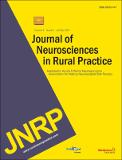Inpatient occupational therapists hand-splinting practice for clients with stroke: a cross-sectional survey from Ireland.

View/
Date
2011Author
Cormican, Adrienne
Chockalingam, Manigandan
Metadata
Show full item recordUsage
This item's downloads: 1168 (view details)
Cited 8 times in Scopus (view citations)
Recommended Citation
Adrienne C, Manigandan C. (2011) 'Inpatient occupational therapists hand-splinting practice for clients with stroke: A cross-sectional survey from Ireland'. Journal of Neurosciences in Rural Practice, 2 (2):141-149.
Published Version
Abstract
Introduction: Hand splinting after stroke is a common practice despite inadequate evidence. This warrants a better
understanding of the therapists’ splinting practice, to develop clinically meaningful treatment options. Aims: The
study examined the nature and prevalence of the factors associated with therapists’ hand splinting practice and their
perceived splinting efficacy. Settings and Design: A cross-sectional national survey of hand-splinting practice among
inpatient occupational therapists (OTs) in Ireland. Materials and Methods: Sixty-two therapists participated in this
national survey.Statistical analysis used: A number of factors were analyzed to explore their relationship with therapists’
perception of splint efficacy using Spearman’s rank order correlation. Results: 53(85.5%) out of 62 survey respondents
prescribed splints to their clients at the time of taking the survey. To reduce spasticity, to correct contractures and thus
increase range of motion (ROM) were the commonly used splinting goals. These were the goals that were significantly
associated with the therapists’ splinting efficacy too. Conclusions: Hand-splint prescription following stroke was
found to be a common practice among OTs who perceive splints to be quite effective. A custom-made, volar forearmbased
wrist-hand splint is the preferred splint among therapists to achieve a number of clinical aims such as improving
ROM, stretching soft tissue contractures and reducing spasticity in the upper extremity. A wide variety of splinting
regimens is currently practiced, reflecting the lack of a universally accepted and comprehensive practice guideline to
regulate therapy. Methodologically valid clinical trials evaluating the efficacy of therapist-preferred splints in achieving
their favored outcomes are needed. Development of common, universally accepted therapeutic guidelines based on
comprehensive scientific review of such studies is thus needed.

